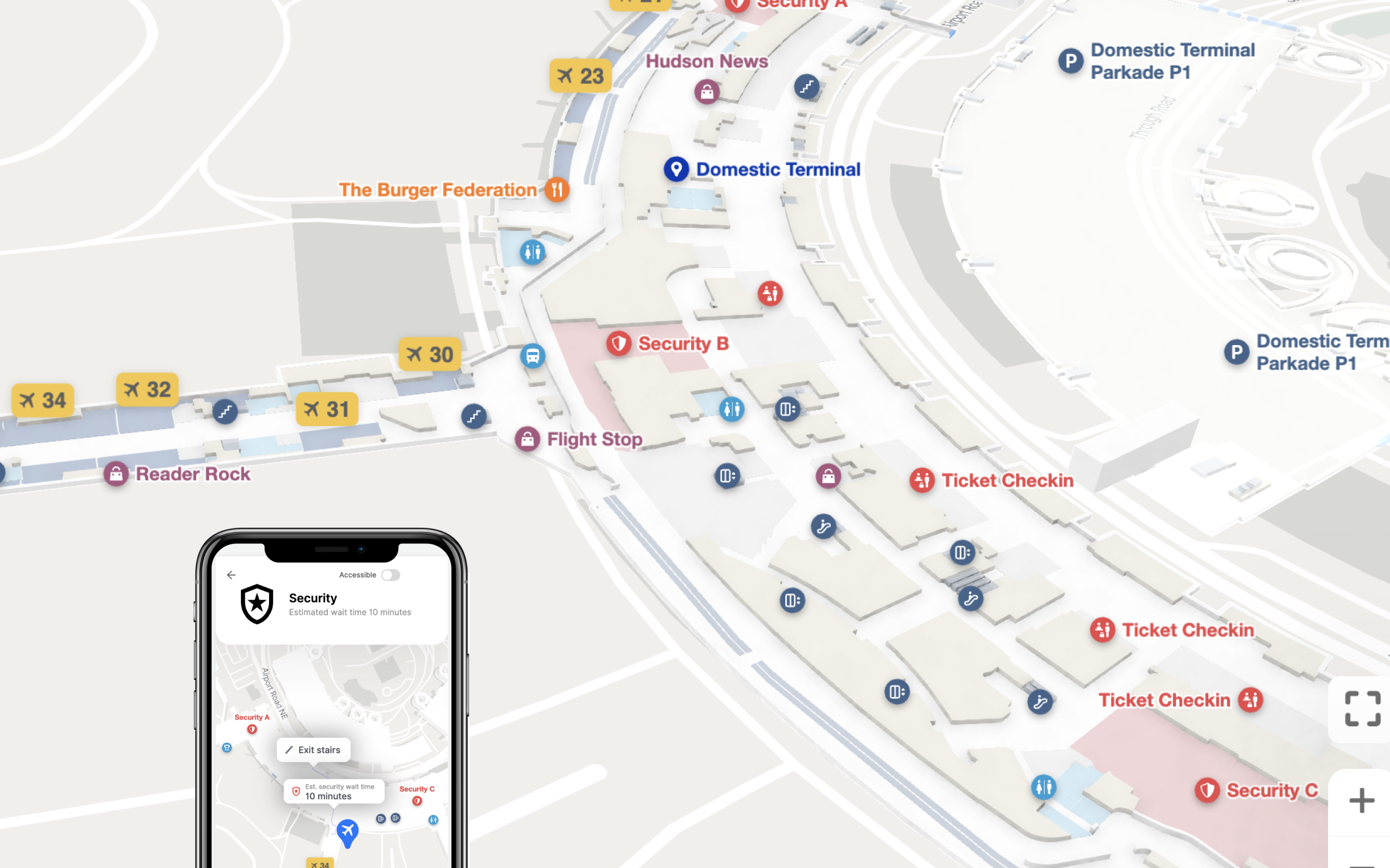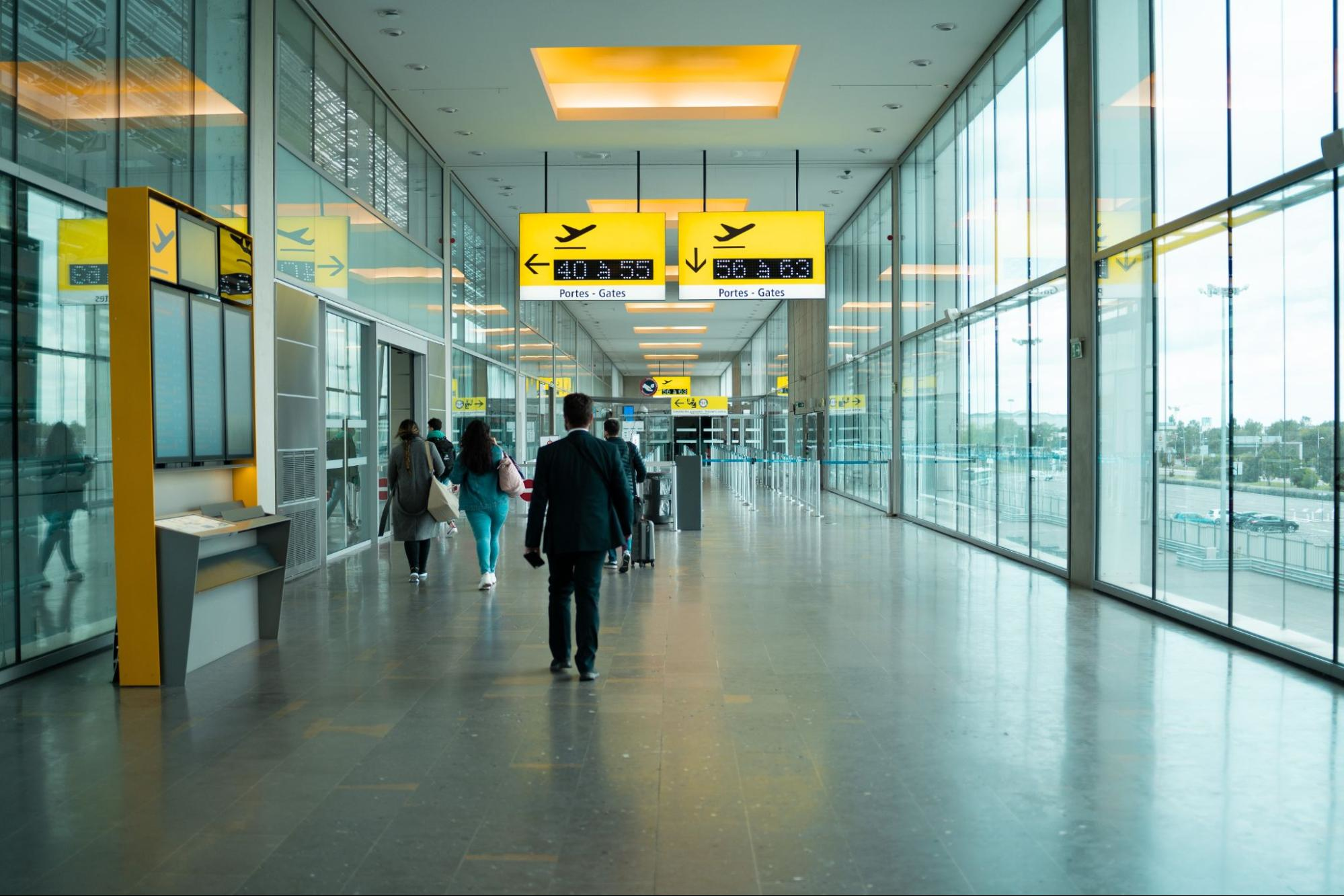Return to Resources
Airport Operations Management - Definition, Types and How to Improve
Dec 4, 2023
6 min read
Have you ever wondered how airports ensure a seamless and stress-free travel experience? In this article, we’ll take a closer look at airport operations – their inner workings, their mission to make passenger journeys as smooth as possible, and the pivotal role of indoor maps in enhancing every aspect of these operations.

What are Airport Operations?
Airport operations encompass the day-to-day activities that keep an airport running smoothly, all while upholding the highest industry standards. A dedicated team of employees ensures that everything, from baggage handling to security checks to flight scheduling, operates seamlessly. These operations are all aimed at one overarching goal: to provide passengers with a stress-free and efficient travel experience.
Types of Airport Operations
Landside Operations
Landside operations focus on everything that happens outside of the airport terminals. This includes parking facilities, road access, passenger drop-off zones, and ground transportation services. Efficient landside operations are essential to minimize traffic congestion, provide convenient parking options, and ensure passengers can easily access the terminal buildings.
Airside Operations
Airside operations, on the other hand, deal with activities within the restricted areas of an airport. These encompass tasks related to aircraft, runways, taxiways, and all aspects of air travel. For instance, ensuring that departures and arrivals of planes occur safely and on schedule is a primary objective of airside operations.
Finance, Billing and Invoicing
The financial aspects of an airport are equally critical. This includes managing budgets, invoicing airlines for services, and handling revenue from various sources like parking fees and concessions. Accurate financial management is essential for controlling costs and ensuring efficiency, allowing for necessary improvements and expansions to meet the evolving needs of the industry.
Information Management
Information management involves handling a vast amount of data related to flight schedules, passenger information, and resource allocation. Effective data management ensures that airport staff can make informed decisions, which in turn, streamlines their processes and leads to better service for passengers and airlines.
Why Is Airport Operations Management Important?
Airport operations management is the backbone of a smoothly functioning airport. It's essential because it ensures that passengers can move through the airport with ease, flights remain on schedule, and security measures are maintained. Without effective operations management, the airport experience could be chaotic and unpredictable, emphasizing the importance of providing excellent customer service and implementing best practices for the satisfaction of all customers.
How to Use Indoor Maps to Improve Airport Operations
Indoor maps offer a multifaceted approach to enhance airport operations, addressing key concerns such as:
Streamlining Staff Tasks
In the bustling environment of an airport, efficient staff task management is crucial. Indoor maps, with their real-time data capabilities, empower airport personnel to streamline passenger flow, optimize baggage handling, and coordinate security checks. This translates to smoother task management, which directly improves the overall passenger experience.
Efficient Resource Allocation

allocation of airport resources, including gates, baggage carousels, and equipment, can be a logistical puzzle. Indoor maps provide a visual representation of real-time data, enabling airport authorities to make informed decisions on resource allocation. Additionally, indoor maps enhance navigation for employees, helping them easily locate and manage resources, which in turn contributes to smoother and more efficient airport operations.
Facilities Management
Maintaining airport facilities is paramount to ensuring a positive passenger experience. Indoor maps come into play here by allowing real-time tracking of facility status and infrastructure. This proactive approach facilitates maintenance and repairs, ensuring that all facilities remain operational and in top condition.
Enhancing Safety and Security
Indoor maps also contribute significantly to enhancing safety and security for both passengers and airport operators. They aid in emergency preparedness by providing a visual layout of the airport, which is crucial during safety inspections and real emergencies. Additionally, real-time data can be used to monitor security checkpoints and respond promptly to potential threats, ultimately making airports safer for everyone.
Airport Operations Job Roles
Airport Information Specialist
Airport Information Specialists are the go-to source of information for passengers. They assist travelers with queries about flights, facilities, and services. Their role is pivotal in ensuring that passengers have a positive experience while navigating the airport.
Airport Operations Officer
Operations officers are responsible for coordinating activities on the ground, ensuring that everything runs smoothly. They oversee tasks like aircraft turnaround, gate assignments, and baggage handling, making sure that flights operate on schedule.
Airport Security Officer
Security officers play a critical role in maintaining the safety and security of the airport. They monitor passengers and luggage, conduct security checks, and respond to potential threats or emergencies, ensuring a secure environment for all.
Air Traffic Controller
Air traffic controllers are responsible for managing the flow of aircraft in the air and on the tarmac around the airport. They ensure safe takeoffs, landings, and efficient routing, helping to prevent delays and accidents.
Airport Operations Training and Education
To excel in airport operations, professionals typically require specialized training and education. Courses and programs in aviation management, airport operations, or related fields provide the knowledge and skills needed to manage and improve airport operations effectively, opening up a world of opportunities for career growth and development.
Frequently Asked Questions

What is Passenger Experience in an Airport?
Passenger experience in an airport refers to the overall satisfaction and ease of travel encountered during a traveler’s journey. It encompasses everything from check-in and security procedures to the availability of amenities and services within an airport. A positive customer experience is crucial for ensuring repeat business.
Why is Passenger Experience Important in Airports?
Passenger experience is vital because it directly impacts an airport's reputation and success. A pleasant and stress-free journey encourages passengers to return, use the airport's facilities, and recommend it to others. Good passenger experiences can lead to increased revenue and growth for the airport.
What Makes a Good Airport Experience?
A good airport experience involves several factors, including efficient check-in and security procedures, a wide range of dining and shopping options, clean and comfortable facilities, clear signage, and helpful staff. It's about making the journey as smooth and enjoyable as possible, leaving travelers with a positive impression of the airport.
Ready to experience the future of smooth and enjoyable airport journeys? Explore our cutting-edge solution, Mappedin Airports, where innovation meets convenience, offering interactive maps, real-time flight information and updates, and a host of features to streamline your airport operations.


